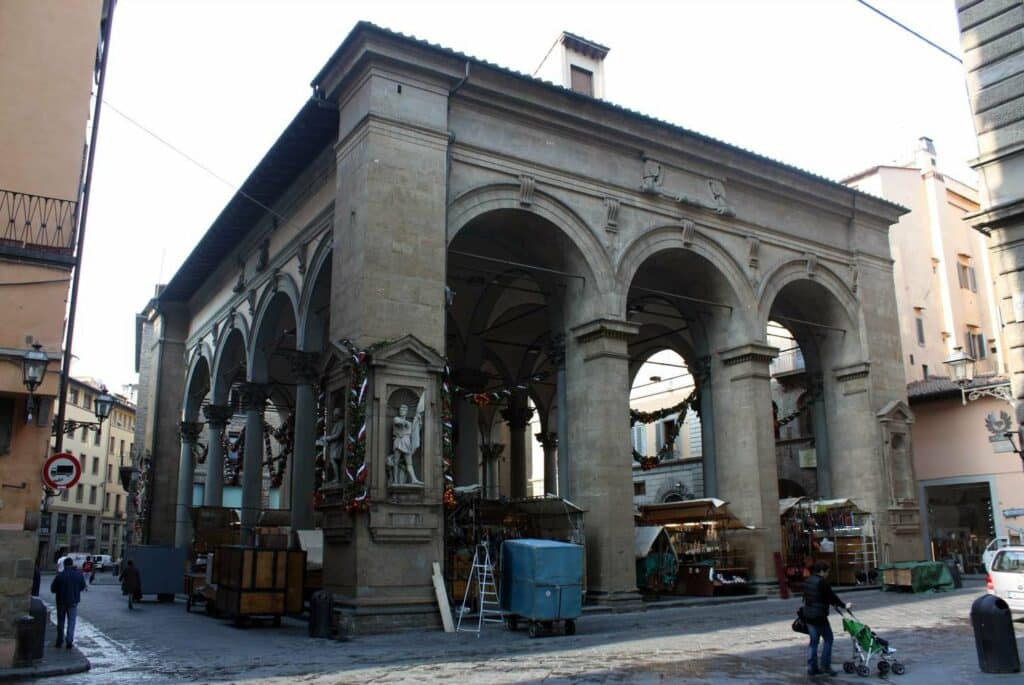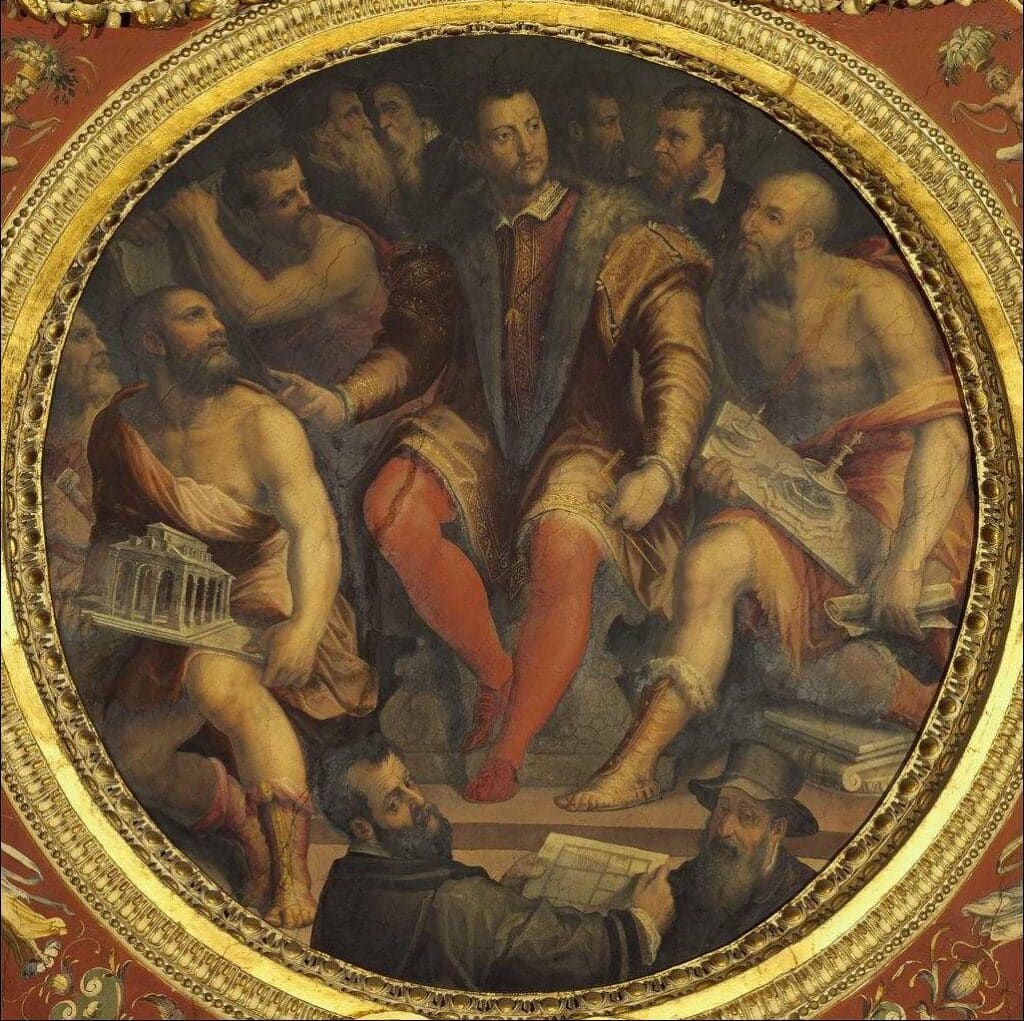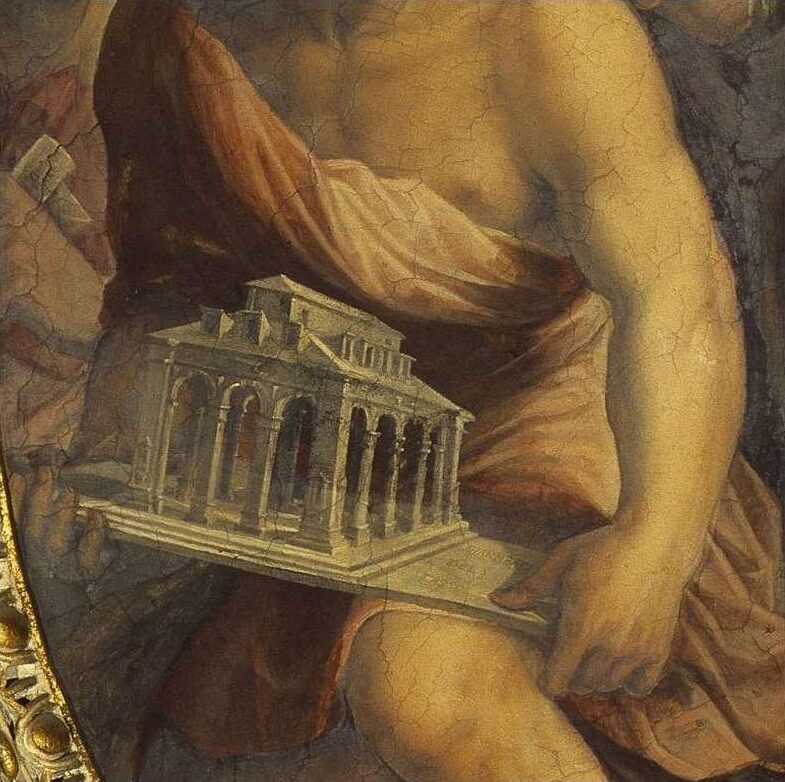Loggia Mercato Nuovo, Florence

A few blocks north of the Ponte Vecchio in Florence one finds the loggia of Mercato Nuovo (1546–51), a rectangular edifice three bays wide and four bays deep, built under Cosimo I de’ Medici. It was constructed as part of a program meant to bolster the trade of gold and silk in Florence. The monumental building has piers that encase an inner structure, which has columns that carry arches defining the bays. Most accounts state that the loggia was constructed to the design of Giovanni Battista del Tasso, who oversaw many collaborative artistic enterprises undertaken in conjunction with Medici patronage. Giorgio Vasari later commemorated Tasso as architect of Mercato Nuovo in a painting in Palazzo Vecchio. Tasso is depicted holding a model of the loggia with an inscription affirming his authorial link to the building. In the construction of the loggia, Tasso deployed two types of stone common to many Florentine Renaissance buildings: pietraforte (used for the piers) and pietra serena (used for the columns and architectural details).
Drawing on Michael Baxandall’s notion of the period eye, I suggest that an early modern understanding of stones and nascent ideas about geology factored into how Mercato Nuovo’s loggia might have been interpreted by discerning viewers. Late medieval and early Renaissance ideas about stones were inherently interdisciplinary, combining empirical knowledge about them as physical objects with their theorisation, particularly with regard to their origination. Powerful thoughts grounded in natural philosophy, natural history, biblical exegesis, divinatory practices, alchemy, magic, astrology, and antiquarianism shaped thinking about stones. With regard to Mercato Nuovo, what is salient is that such an understanding of stone suggests that its use imbued the loggia with a qualitative sense of vibrancy. Theories of the formation of stones charged the loggia’s physical material with a potency common to both the formation of stones and organic creatures. My ambition is not to imply that the lithic materials used were viewed as inherently vivacious, however, but rather to argue that for sixteenth-century Florentines, there perhaps was a sense that stone evoked the notion of living history, in that the stone’s object biography was deeply aligned with the growth of the earth.


While geology as a discipline was far from being codified as such in early modernity, contemporary Europeans were keen to apprehend and reveal the causal processes behind terrestrial land forms seen first-hand. The most widely read works that explored topics related to the phenomena of the physical earth were Pliny’s thirty-six volume Natural History (Naturalis historia), composed in the second century A.D. and Albert Magnus’s De mineralibus et rebus metallicis, a commentary on Aristotle’s Meterologia written around the 1260s and first printed in 1476. Both Pliny and Albert Magnus were standard references which remained popular even after Agricola’s De re metallica was published in 1556. Pliny did not offer a sustained discussion of stones, but when he commented on them his remarks focused primarily on addressing their magical and medicinal powers. He believed some stones to be gendered, observing that some could bear offspring.
From antiquity through the sixteenth century there were three main theories articulated about the origin of stones, many of which were influenced by Pliny, Aristotle, and Albertus. When in 1502 Leonardus Camillus claimed that stones were produced due to God’s will, on account of stellar and planetary reasons, and because of changes in elemental qualities — by which he meant different combinations of heat, cold, dryness and dampness — he followed, in essence, an Aristotelian understanding of matter and its celestial influences. Aristotle taught that because of the influence of the sun or heating actions, stones grew on the surface of the earth or its interior in places where conditions favourably caused exhalations. A second strand of thought forwarded the idea of the ‘petrific seed’ in which minerals (or stones) sprung from a seed, which either had or was held by analogy to have powers of insemination. The final line of thought posited that a fluid body circulated through the earth’s crust that in certain circumstances could turn substances into stone. The year Tasso embarked on constructing Mercato Nuovo, Agricola published The Birth and Causes of the Subterranean, claiming that minerals — and by extension rocks as the aggregate of minerals — occur after a lapidifying juice (succus lapidescens) deposited some of its mineral content, which happened due to drying heat or freezing cold.
Whereas medieval scholars assembled lists of bestiaries, herbariums, and lapidaries that addressed the formation of the earth generically, with the rise of humanism and explorations of the New World, secular and ecclesiastic figures alike wrote descriptions and explanatory theories of the earth as a way of comprehending not just history in an epic sense, but also a geographically bounded history, which is to say local history.This particular interest involved classifying and categorising rocks in a way that stressed geophysical place. In his study On the Nature of Fossils (De natura fossilium) published in 1538, the Veronese physician Girolamo Fracastro departed from many earlier authors who often, like the previously mentioned Leonardus in his treatise on stones, grouped stones according to their hardness or softness, as well as other attributes including their porosity, gravity, and density. Fracastro was among the first to emphasise the specific origin as well as the composition and appearance of minerals and stones when classifying them.
To return to Mercato Nuovo, then, I want to posit that the loggia was erected in an intellectual climate in which there was a desire to understand stones as participants in the construction of history — be it the history of the earth or the history of a specific locale or a conflation of places evoked within the religious and cultural imagination. With regard to the materials used to construct Mercato Nuovo’s loggia, then, Medicean power was grounded and naturalised by analogy though theories about the origination of stones, which, when glossed onto buildings like Mercato Nuovo, etched the Medici into local history as well was history of the longue durée.
